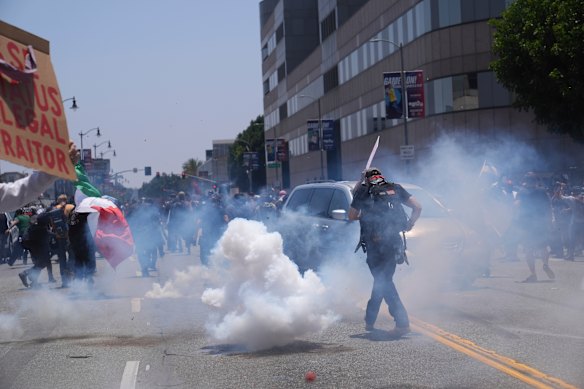Just five months ago, in the weeks around his inauguration, Donald Trump pretty much left Los Angeles to burn. Now LA police are clearly targeting journalists in the belief they have permission to open fire as the US President reprehensibly fans the flames of violence.
Since protests against federal immigration raids started last week in the heavily Latino city, the Los Angeles Press Club has documented more than 20 examples of crowd control weapons and tear gas being used on the media, including Nine correspondent Lauren Tomasi, who was hit in the leg by a rubber bullet. She and a cameraman were easily identified and were off to one side of the police when an officer turned, drew a bead and pulled the trigger. Subsequently, ABC correspondent Lauren Day and her crew were tear-gassed when police dispersed demonstrators, and an ABC camera operator was hit by a round while filming.

Tear gas is used near protesters in downtown Los Angeles this week.Credit: AP
Prime Minister Anthony Albanese said the attacks were unacceptable: “We have already raised these issues with the US administration … and we think that the role of the media is particularly important.”
With controversy mounting, the LAPD is reviewing the shooting of journalists by their officers. There is little reason to believe they will stop targeting the media. Books and films have long highlighted the force’s corruption and cover-ups. In 1991, a video of four LAPD officers beating Rodney King made the force a byword for police brutality and led to riots, but little reform.
Meanwhile, invigorated by poll support for his actions on immigration, Trump called protesters “animals” and “a foreign enemy”. He ordered 2000 California National Guard personnel and then 700 Marines into the streets of Los Angeles. With the downtown now under curfew, protests are starting to spread across other US cities.
While immigration has sent Americans into the streets, police attacks on journalists covering the protests raise fresh concerns about press freedom.
Loading
LA Police actions also highlight how law enforcement is sheltering behind Trump’s obsession with handicapping the media – defunding Voice of America, Radio Free Europe and Radio Free Asia, threatening major networks and virtually blackballing The Associated Press for defying his renaming of the Gulf of Mexico – that have not been servile flatterers.
Free speech is protected by the First Amendment to the US Constitution. It permits the media to speak truth to power, but America under Trump has allowed journalism to be demeaned.